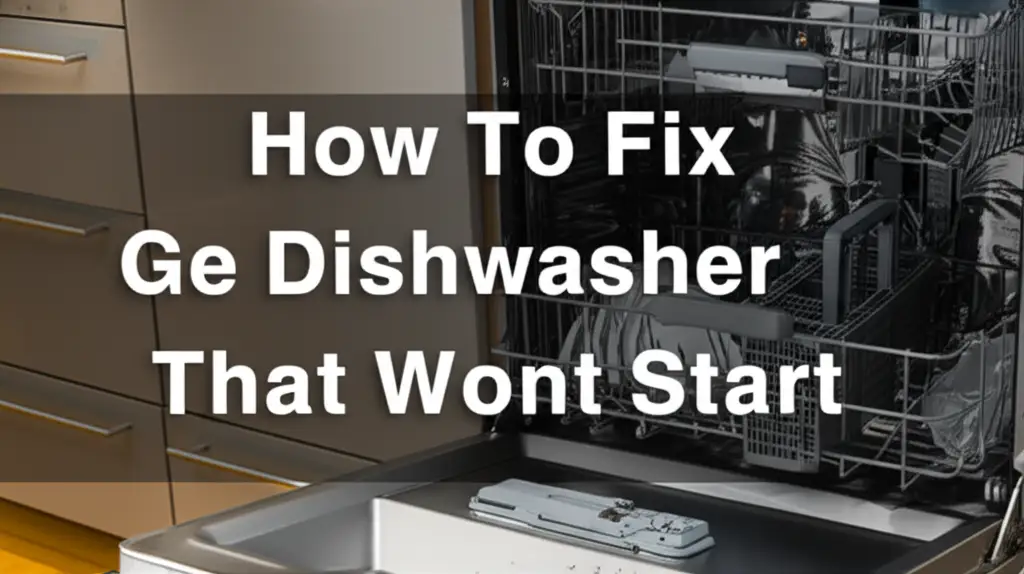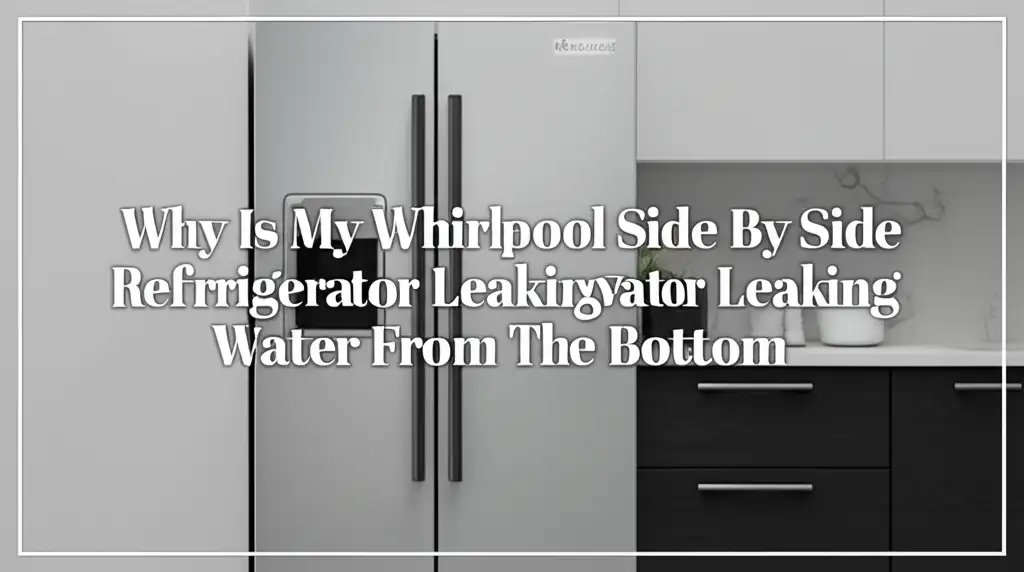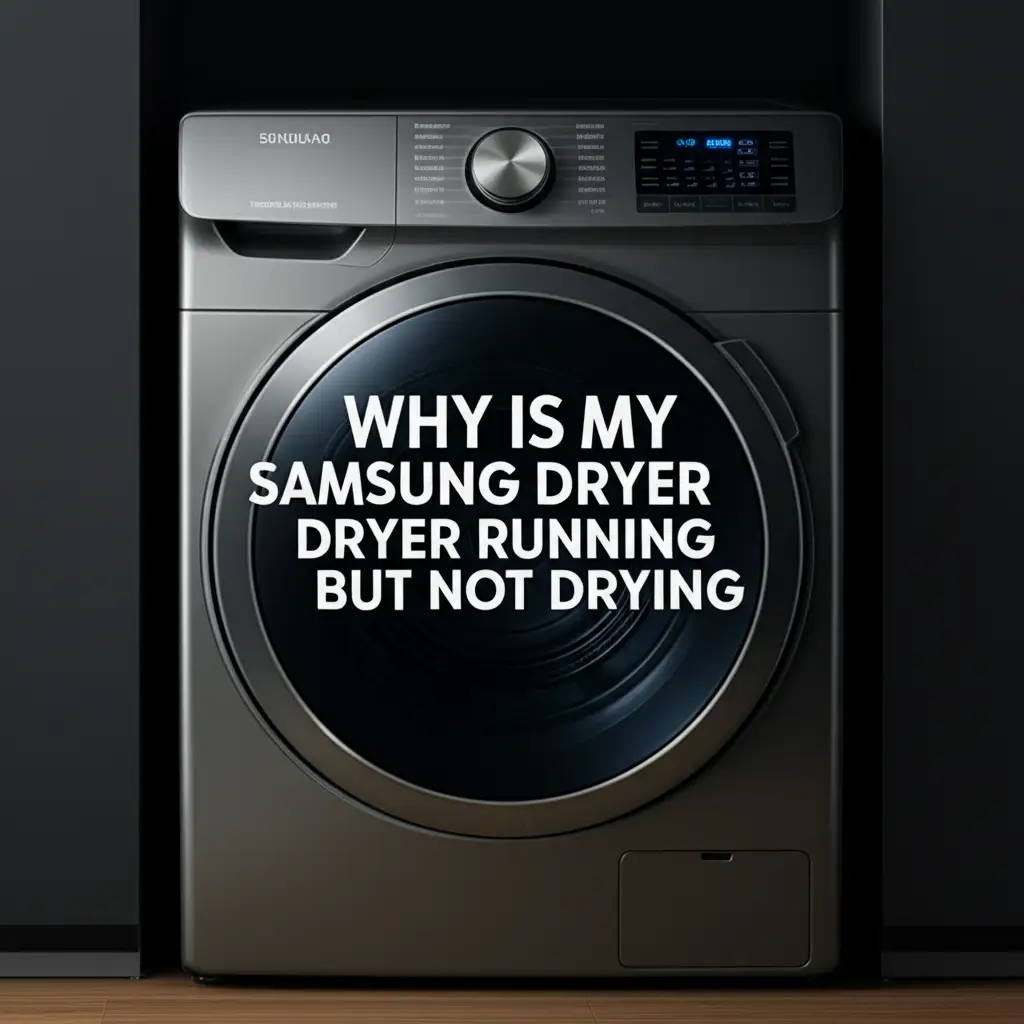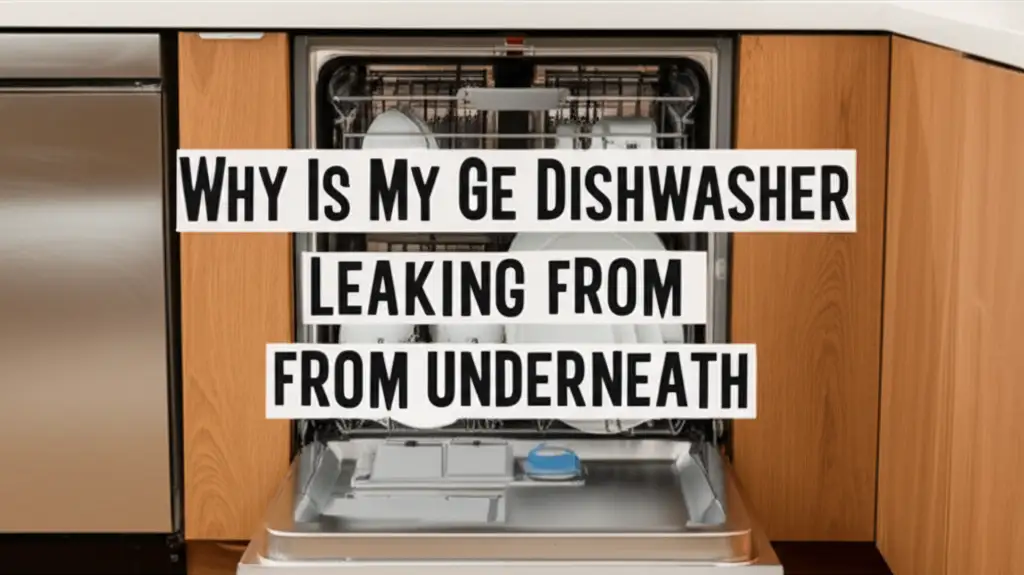· Todd Martin · Appliance Repair · 20 min read
Why Does My Side By Side Refrigerator Leak Water On The Floor
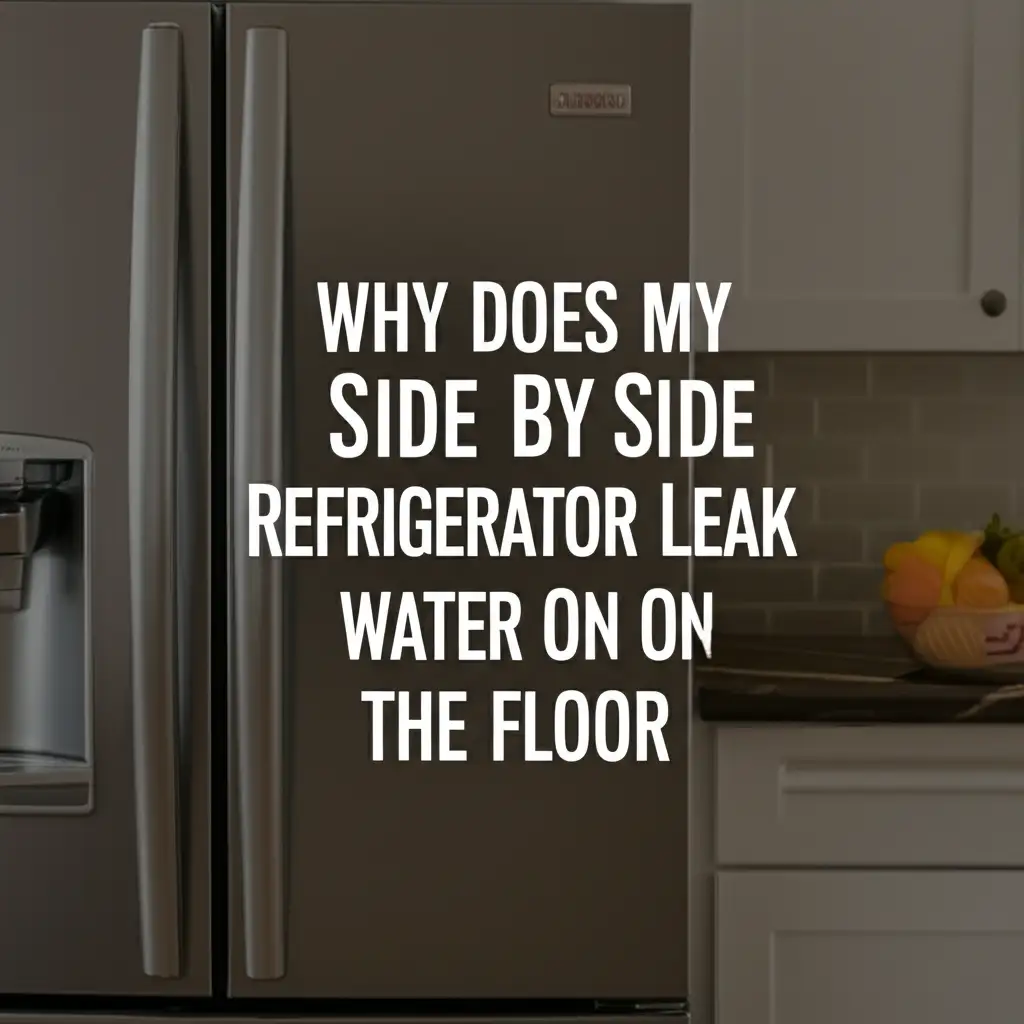
Fixing Your Side By Side Refrigerator Leak: Why Water Hits Your Floor
There are few things as unwelcome as finding a puddle of water around your refrigerator. It is frustrating to step onto a wet floor, especially when the source is a large appliance like your side by side refrigerator. A leak can cause floor damage, create a slipping hazard, and even invite mold growth. Understanding why your side by side refrigerator leaks water on the floor is the first step toward fixing it.
This article explores the common culprits behind refrigerator leaks. We will guide you through diagnosing the problem, providing clear steps for troubleshooting. You will learn about issues ranging from a clogged defrost drain to a faulty water inlet valve. We also cover how to approach simple repairs yourself, helping you keep your kitchen dry and your appliance running well. Let’s get your side by side refrigerator back in perfect working order.
Takeaway
- Check the Defrost Drain: A clogged or frozen defrost drain line is a common cause. Clear it to restore proper drainage.
- Inspect Water Connections: Look for loose or cracked water supply lines and a faulty water inlet valve. Tighten or replace as needed.
- Examine the Drain Pan: Ensure the drain pan is not cracked or overflowing. Clean it regularly.
- Troubleshoot the Ice Maker: Ice maker issues, like a misaligned fill tube, often cause leaks. Verify components are correctly seated.
- Evaluate Door Seals: Damaged or dirty door gaskets can lead to condensation leaks. Clean or replace seals for a tight closure.
Why Does My Side By Side Refrigerator Leak Water On The Floor?
A side by side refrigerator leaks water on the floor primarily due to a clogged or frozen defrost drain line. Other common reasons include a faulty water inlet valve, a cracked or loose water supply line, or issues with the ice maker system. An overflowing or damaged drain pan also causes water to accumulate outside the unit.
The Clogged or Frozen Defrost Drain Line Problem
One of the most frequent reasons your side by side refrigerator leaks water on the floor is a clogged or frozen defrost drain line. This line removes melted frost from the freezer compartment. When it gets blocked, water has nowhere to go. The water then overflows into the bottom of the freezer or refrigerator, eventually seeping onto your kitchen floor.
Identifying the Issue
You often find water pooling under the freezer door or inside the fresh food compartment if the defrost drain is the culprit. Ice might also build up on the freezer floor. This ice indicates that the water cannot drain away properly. The defrost cycle runs periodically, melting frost from the evaporator coils. If the drain is blocked, this melted water backs up.
Steps to Clear the Drain
Clearing a clogged or frozen defrost drain line is a common DIY repair. First, you need to unplug the refrigerator for safety. Locate the drain pan at the bottom of the unit. Accessing the drain opening often requires removing the freezer’s back panel or bottom shelf. This drain opening leads to a tube that directs water to the drain pan.
For a clog, use warm water and a turkey baster or a small, flexible brush to flush the drain. You can also try using a pipe cleaner to dislodge any debris. If it is frozen, a hairdryer on a low setting or a steam cleaner can melt the ice. Direct the heat into the drain tube carefully. Make sure all the ice is gone before reassembling the unit. After clearing the drain, it is a good idea to perform a general cleaning. This helps prevent future blockages. You might also need to clean under the refrigerator to remove any debris that could affect the drain pan.
Understanding the Water Inlet Valve
The water inlet valve controls the flow of water into your side by side refrigerator. It supplies water to both the ice maker and the water dispenser. If this valve is faulty or has a loose connection, it can easily lead to a significant side by side refrigerator leak. A leak from this valve often appears at the back of the refrigerator, near the bottom.
How the Valve Works
The water inlet valve is an electrically operated valve. It opens when the ice maker or water dispenser calls for water. Water flows from your home’s main supply line through this valve into the refrigerator. A small screen inside the valve filters out sediment. If this screen gets clogged, it can restrict water flow, putting strain on the valve. Over time, the valve components can wear out.
Diagnosing Valve Problems
Inspecting the water inlet valve for leaks requires careful observation. Unplug your refrigerator first for safety. Locate the valve, typically at the lower rear of the unit. Look for signs of water drips or mineral deposits around the valve itself or its connections. Sometimes, the valve body itself cracks, causing a slow drip that accumulates into a puddle.
Check the tightness of the compression fittings where the water supply line connects to the valve. These connections can loosen over time. A small leak here can go unnoticed until a significant puddle forms. If the valve is constantly dripping, it might be stuck partially open or have an internal defect. Replacing a faulty water inlet valve is often necessary to stop this type of side by side refrigerator leak. This ensures water only flows when it should, and without drips. This component is crucial for the water dispensing system, including the ice maker. Learning how to replace the water filter in your side by side refrigerator can also give you familiarity with your water system components.
Issues with the Water Supply Line
Another common reason your side by side refrigerator leaks water on the floor is a problem with the water supply line. This line carries water from your home’s plumbing to the refrigerator’s water inlet valve. A leak can occur if the line is cracked, punctured, or if its connections are loose. These leaks often start subtly but can quickly lead to large puddles.
Inspecting Water Lines
To check the water supply line, you first need to pull your refrigerator away from the wall. This gives you full access to the back of the unit. Carefully examine the entire length of the water line, from the wall connection to where it enters the refrigerator. Look for any visible cracks, kinks, or punctures in the plastic or copper tubing. Even a small pinhole can cause a significant leak over time.
Also, pay close attention to the fittings at both ends of the line. The connection to the water shut-off valve on the wall and the connection to the refrigerator’s water inlet valve must be secure. Feel for dampness around these connections. Sometimes, the issue is not a crack in the line itself, but rather a loose nut that allows water to escape. Remember to turn off the water supply to the refrigerator before you start checking or tightening any connections. This prevents additional water spillage.
Repairing or Replacing
If you find a minor leak at a connection, you might simply need to tighten the fitting with a wrench. Do not overtighten, as this can strip threads or crack plastic components. For a cracked or punctured line, replacement is usually the best option. Water supply lines are relatively inexpensive and can be found at most hardware stores. Make sure to buy the correct length and material (typically braided stainless steel or copper for durability).
Replacing the line involves turning off the water, disconnecting the old line, and attaching the new one. Ensure all connections are secure. If your refrigerator has an ice maker or water dispenser, maintaining a clean water line for these features is important. A clean line helps prevent sediment buildup which can also contribute to leaks. Consider using a new compression fitting for a secure seal when replacing the line.
Malfunctioning Ice Maker System
The ice maker system in your side by side refrigerator is a common source of leaks. It involves several components: a water fill tube, the ice mold, and a shut-off mechanism. Problems with any of these parts can cause water to overflow and leak onto the floor. Ice maker leaks often appear inside the freezer compartment first, then flow out.
Common Ice Maker Leak Points
One frequent issue is a misaligned or cracked ice maker fill tube. This tube delivers water into the ice mold. If it shifts out of place, water can miss the mold entirely, spilling into the bottom of the freezer. Over time, the plastic tubing can also crack, causing a leak directly from the tube itself. Another problem can be a faulty water level sensor or a stuck fill valve. These issues cause the ice maker to overfill the mold, leading to water overflowing the tray.
Additionally, a clogged drain channel beneath the ice maker can contribute to leaks. If the channel designed to catch drips is blocked, water will pool and find its way out. You might also find that an ice jam prevents proper dispensing, causing ice to back up and melt, leading to a leak. It is vital to inspect all these components.
Troubleshooting Ice Maker Leaks
To troubleshoot an ice maker leak, start by opening the freezer door and observing the ice maker’s operation. Unplug the refrigerator before you begin any hands-on inspection. Check the fill tube for cracks or misalignment. If it is misaligned, you can often gently push it back into position. Make sure it directs water precisely into the ice mold.
If the ice maker overfills, the water inlet valve might be the problem, or the ice maker’s internal fill sensor could be faulty. Cleaning the ice maker can also resolve many issues. Remove any ice buildup around the mold and ensure the drain channels are clear. Sometimes, simply cleaning the ice maker thoroughly solves the problem by removing obstructions. If you suspect the water inlet valve, you might need professional help to replace it. This ensures your ice maker makes ice correctly without creating a side by side refrigerator leak.
The Overflowing or Damaged Drain Pan
Underneath your side by side refrigerator is a drain pan. This pan catches water from the defrost cycle and evaporation from the freezer. Most of this water evaporates naturally due to the heat from the condenser coils. However, if the pan overflows or becomes damaged, water will certainly end up on your kitchen floor. This is a common cause for a persistent side by side refrigerator leak.
Locating the Drain Pan
The drain pan, also known as the drip pan, is typically located at the very bottom of your refrigerator, near the back. To access it, you will need to pull your refrigerator out from the wall. The pan usually slides out or is held in place by a few screws. Once you locate it, you can inspect its condition.
You should check for several things. First, see if the pan is simply full of water. This can happen if the evaporation process is not working efficiently, perhaps due to restricted airflow from dirty condenser coils. Second, inspect the pan for any cracks or holes. Even a small crack can allow water to seep out over time. Sometimes, the pan might be dislodged or tilted, preventing it from holding water properly.
Cleaning and Replacing the Pan
If the drain pan is full but not cracked, it might indicate a problem with evaporation. Ensure the condenser coils, located near the pan, are clean. Dirty coils reduce the heat needed for water evaporation. You can learn how to clean refrigerator coils effectively to improve this. If the pan is cracked or severely damaged, replacement is the only solution. You can typically order a replacement drain pan specific to your refrigerator model.
To clean the pan, simply slide it out and empty the water. Wash it with warm, soapy water to remove any slime or mold buildup. Use a soft brush for scrubbing. Rinse it thoroughly and dry it before placing it back. A clean pan helps prevent odors and mold growth. If you found a crack, replace it to prevent further water leaks. Regularly checking and cleaning the drain pan can prevent many instances of a side by side refrigerator leak from becoming a major issue. This is especially true for leaks originating from the bottom of the unit.
Condensation Issues and Door Seal Problems
Condensation inside your refrigerator is normal to a degree, but excessive moisture can lead to a side by side refrigerator leak. This often points to issues with the door seals or gaskets. When seals are faulty, warm, humid air enters the cold compartments. This air condenses into water droplets, which can accumulate and drip onto the floor.
Understanding Condensation
Condensation occurs when warm, moist air meets a cold surface. Inside your refrigerator, the air is kept cold and dry. If outside air consistently infiltrates, moisture will form. This happens particularly on the interior walls and shelves. While a small amount of condensation is normal, large puddles or consistent dripping suggest a problem.
The refrigerator works hard to maintain its internal temperature. When warm air leaks in, the compressor runs more frequently. This not only causes condensation but also increases your energy bill. The water formed can then drip down, bypass internal drainage systems, and find its way onto your kitchen floor. This type of side by side refrigerator leak can be frustrating because it often starts subtly.
Checking Door Seals
The door seals, or gaskets, are the rubber or magnetic strips around the edge of the refrigerator doors. They create an airtight seal when the doors are closed. To check your door seals, perform a simple paper test. Close the refrigerator door on a piece of paper, half in and half out. If you can easily pull the paper out, the seal is weak at that spot. Repeat this test around the entire perimeter of both doors.
Another way to check is to visually inspect the seals for cracks, tears, stiffness, or mold. Dirty seals can also prevent a tight closure. If the seals are dirty, cleaning them thoroughly with warm, soapy water might solve the problem. However, if they are cracked or stiff, they need replacement. Replacing door seals is a relatively straightforward repair that can significantly improve your refrigerator’s efficiency and prevent a side by side refrigerator leak caused by condensation. It helps your appliance maintain its proper temperature.
The Impact of Clogged Condenser Coils
While not a direct cause of a side by side refrigerator leak, clogged condenser coils can indirectly contribute to one. Dirty coils make your refrigerator work harder to cool. This increased workload can lead to warmer temperatures inside the unit, impacting the efficiency of the defrost system and potentially causing other components to malfunction. This chain reaction can result in water accumulation and leaks.
Impact of Dirty Coils
The condenser coils are responsible for releasing heat from the refrigerant into the room. When these coils are covered in dust, pet hair, and debris, they cannot dissipate heat efficiently. This forces the compressor to run longer and hotter. The refrigerator’s interior might not get as cold as it should. This can affect the freezer’s defrost cycle. If the freezer warms slightly, ice might melt more frequently or unevenly. This can overwhelm the defrost drain system, leading to clogs and water overflowing into the drain pan.
Moreover, an overworked compressor can cause other components, like the water inlet valve or the drain pan, to behave improperly due to thermal stress. While it is not a direct plumbing issue, maintaining clean coils is vital for overall refrigerator health. It helps prevent a host of problems, including an indirect side by side refrigerator leak.
How to Clean Coils
Cleaning your condenser coils is a simple maintenance task you can do yourself. First, unplug your refrigerator from the wall outlet to ensure safety. The condenser coils are usually located at the back of the refrigerator or sometimes underneath, behind a removable grille. For coils at the back, you will need to pull the refrigerator away from the wall. For coils underneath, you might need to remove a kick plate.
Use a vacuum cleaner with a brush attachment to gently remove dust and debris from the coils. A coil brush, which is long and flexible, can help reach tight spots. Be thorough, as even a small amount of dust can reduce efficiency. After cleaning, push the refrigerator back into place and plug it in. Regular cleaning of condenser coils, ideally twice a year, helps your refrigerator run efficiently. It also reduces the likelihood of issues that could contribute to a side by side refrigerator leak. This also improves the lifespan of your appliance. Knowing how to clean your refrigerator coils is a key part of regular maintenance.
Understanding Refrigerator Leveling
Proper leveling of your side by side refrigerator is more critical than you might think when troubleshooting a water leak. An unlevel refrigerator can cause water to pool unevenly within the internal drainage systems. This can lead to overflow and, eventually, a side by side refrigerator leak onto your kitchen floor. The slight tilt can cause water meant for the drain pan to run elsewhere.
Why Leveling Matters
Refrigerators are designed with internal components and drainage pathways that rely on a level surface to function correctly. For example, the defrost drain pan is engineered to collect water evenly and allow it to evaporate. If the refrigerator tilts forward or backward, water can slosh out of the pan. If it tilts to one side, water might not reach the drain opening effectively and instead flow into the fresh food section or onto the floor.
Additionally, proper leveling ensures the refrigerator doors seal correctly. An unlevel unit can cause the doors to hang slightly ajar. This leads to air leaks and increased condensation, as discussed earlier. Condensation buildup can contribute to a leak by overwhelming the internal drainage. Even a small tilt can disrupt the delicate balance required for the refrigerator’s drainage system.
Adjusting the Leveling Feet
Most side by side refrigerators have adjustable leveling feet or rollers at the bottom corners. You can typically find two at the front and sometimes two at the back. To check the level, place a carpenter’s level on top of the refrigerator. Check it both from side to side and front to back. The bubble should be centered.
To adjust, you might need to tilt the refrigerator back slightly or have someone help you lift one corner. Turn the leveling feet clockwise to raise a corner and counter-clockwise to lower it. Make small adjustments at a time. The front of the refrigerator should be slightly higher than the back. This helps the doors close firmly on their own. Once the refrigerator is level, recheck the door seals to ensure they close tightly. Correct leveling is a simple step. It can prevent unexpected water puddles and contributes to the overall efficiency of your side by side refrigerator, preventing a needless side by side refrigerator leak.
Preventing Future Refrigerator Leaks
Preventing a side by side refrigerator leak often comes down to regular maintenance and proactive checks. Just like any major appliance, your refrigerator benefits from consistent care. Taking a few simple steps can save you from messy puddles and expensive repairs in the long run. Proactive maintenance helps catch small issues before they become big problems.
Regular Maintenance Schedule
Establish a routine for checking your refrigerator. I recommend doing a quick visual inspection monthly. Look for any signs of moisture inside or around the unit. Twice a year, pull the refrigerator out and perform more thorough maintenance. This includes cleaning the condenser coils and the drain pan. These are simple tasks that make a big difference.
It is also a good idea to check the water supply line and its connections periodically. Make sure they are tight and free from cracks. For models with an external water filter, replace it according to the manufacturer’s recommendations. A clogged filter can restrict water flow and put strain on other components. These small checks add up to a longer, leak-free life for your appliance.
Addressing Small Issues Promptly
Do not ignore minor signs of trouble. A small drip or a bit of ice buildup in the freezer can be early warnings of a larger problem. Investigate these issues right away. For example, if you notice the door is not sealing perfectly, try cleaning the gasket. If that does not work, consider replacing it. Addressing these issues immediately prevents them from escalating into a full-blown side by side refrigerator leak.
If you hear unusual noises, like constant running or strange gurgling, it might indicate a system working too hard. This could also indirectly lead to leaks by stressing components. If a problem seems beyond your comfort level to fix, do not hesitate to call a professional. Early intervention is always better than waiting until water is flooding your kitchen. Protecting your home from water damage is important, and proactive refrigerator care is a key part of that.
FAQ Section
Q1: Can I fix a refrigerator leak myself, or do I need a professional?
Many common side by side refrigerator leaks, such as a clogged defrost drain or a loose water supply line, are often fixable with basic tools. I have personally handled several of these issues. However, if the problem involves complex electrical components, sealed systems, or if you are unsure about the diagnosis, calling a qualified appliance technician is the safest option. Knowing your comfort level for DIY repairs is key.
Q2: How do I prevent future side by side refrigerator leaks?
Regular maintenance is crucial for preventing leaks. I always recommend cleaning the condenser coils and defrost drain pan every six to twelve months. Check the water supply line and its connections for tightness periodically. Also, ensure your refrigerator is level and that the door seals are clean and intact. These simple steps significantly reduce the risk of a side by side refrigerator leak.
Q3: Is a refrigerator leak dangerous?
A refrigerator leak itself is not inherently dangerous in terms of immediate harm, but it can create hazards. Water on the floor is a slipping hazard. Prolonged moisture can damage flooring and cabinetry, leading to mold growth. Mold can cause respiratory issues. Electrical components exposed to water also pose an electrocution risk. Always unplug the refrigerator before investigating a leak to ensure safety.
Q4: How much does it cost to fix a refrigerator leak?
The cost to fix a side by side refrigerator leak varies greatly. Simple fixes like clearing a drain or tightening a connection might cost nothing beyond your time. Replacement parts like a new drain pan or water line are often affordable, ranging from $20 to $100. If you need a professional, labor costs can add $100-$300 or more, plus parts. Complex repairs like a new water inlet valve or compressor can be higher.
Q5: Why is my new side by side refrigerator leaking?
Even new side by side refrigerators can leak. The most common reasons for a new unit to leak involve installation errors, such as a kinked or improperly connected water supply line. Sometimes, a component might be faulty from the factory, like a defective water inlet valve. Always check installation steps and initial connections. If issues persist, contact the manufacturer or retailer for warranty service.
Conclusion
Finding water on your kitchen floor from a side by side refrigerator leak can be a real headache. As we have explored, the causes range from common household clogs to more involved component failures. Understanding these potential issues empowers you to take action. I hope this guide helps you diagnose and resolve the problem effectively. Whether it is a simple matter of clearing a defrost drain, tightening a water line, or addressing an ice maker issue, many of these repairs are within your grasp.
Remember, consistent maintenance is your best defense against unexpected leaks. Regularly cleaning components like the condenser coils and checking door seals extends the life of your appliance. If you find yourself facing a side by side refrigerator leak that feels too complex, or if you are unsure about the repair, do not hesitate to seek professional help. Your peace of mind and the longevity of your appliance are worth it. Take action to keep your home dry and your refrigerator running smoothly.


